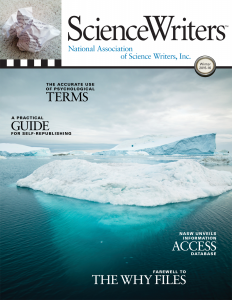By Dennis Meredith
Over recent years, more and more research institutions seem to be adopting a corporate marketing approach to their communications. You can recognize these marketers by their use of such buzzwords as branding, messaging, market penetration, and cost-benefit analysis. It’s an approach that risks compromising research communications, and more broadly a research institution’s missions to create and disseminate knowledge.
Administrators become enamored of a corporate marketing approach because they’re managers, and managers like to manage stuff. Corporate marketing offers them a chance to manage: A seemingly strategic way to “sell” the institution to key customers, such as prospective students, patients, and donors. True, the marketing approach does have some utility, in that it can help academic institutions think more strategically about communicating core messages about the institution.
But corporate marketing is by definition shallow marketing. By aiming to sell the institution as a branded product, it fails to serve the intellectually rich marketplace of ideas in which researchers operate.
For example, corporate marketers too often abandon significant coverage of their institutions’ research; particularly basic research. They don’t see such coverage as serving their narrow marketing strategy. In fact, I’ve heard of communicators at some marketing-oriented research universities explicitly stating that they don’t do news releases on basic research advances.Rather, marketers prefer the “sales rep PIO” approach to media relations. For example, they will expend considerable effort to get their researchers quoted in reaction to news of the day. But these mentions are basically trivial: the equivalent of corporate product placements. They don’t really advance the researchers’ ideas, but only give the institution’s visibility or, as marketers put it, “increase media impressions.”
Another hallmark of the marketing mentality is pitching stories to individual reporters to generate media “placements.” While pitching seems like a good tactic (generating documentable media “hits”), it’s a poor long-term communication strategy. For one thing, it relegates the institution’s news to a commodity to be sold like soap, reducing the institution’s credibility. Also problematic: Pitching could be considered ethically questionable, since it constitutes a publicly funded institution preferentially offering a story idea to one reporter. Certainly, other reporters not privy to that information wouldn’t be happy with such preferential treatment.
Ideas should be broadcast, not pitched. Good ideas, well communicated, will find their audiences, both reporters and the public.
A more credible and productive alternative model to sales rep PIOs is the “PIO journalist.” The PIO journalist doesn’t pitch stories, or produce releases that are essentially advertisements peppered with such subjective terms as “breakthrough,” “revolutionary,” and “major discovery.” (To see sales rep PIOs at work, search for these terms on EurekAlert! or Newswise.)
Rather, the PIO journalist produces a steady flow of newsworthy releases, compelling feature stories, and videos. Like any media reporter, the PIO journalist seeks to vividly communicate research by creating stories with clear explanations, pithy quotes, and memorable metaphors. The stories explain the implications of discoveries in a way that scientific papers do not. More importantly, the PIO journalist includes the caveats and cautions that any good journalist would feature, which makes the release more credible.
Over the long term, such compelling content obviates the need for pitches. Reporters come to understand that the institution’s track record of solid news and features mean that they are obliged to pay close attention to its communications. Administrators may not resonate as much with PIO journalism as with corporate marketing, because there’s much less for them to “manage.” Their duties consist of hiring talented research communicators and giving them the resources they need to do their jobs.
Administrators need to appreciate that the resulting “products” will be news releases and other content that better serve the institution’s interests by portraying it as a dynamic, creative source of new discoveries. Such releases effectively transmit those discoveries to the idea marketplace, where they will be seen by such important audiences as fellow researchers, prospective graduate students, and corporate partners. PIO journalists tell the institution’s research story the way that the researchers and the institution want it told, and not through the filter of the media. For example, news releases posted on such services as EurekAlert! and Newswise automatically appear on such news syndicators as Google News, right along with media stories. And content posted on the institution’s websites and social media directly reach audiences.
PIO journalists also recognize that media may sometimes be secondary targets of news releases: that releases have a multitude of uses beyond media alerts. For example, they serve as internal communications, as statements of record, as alerts to other researchers, and as content to inform and engage prospective students and faculty, corporate partners, and donors.
So, the next time you find yourself in the soap aisle of the supermarket, ask yourself whether research discoveries should really be considered the equivalent of the gaudy packages of detergents festooned with their punchy slogans.
_Dennis Meredith, science communication consultant, dennis@glyphus.com
(NASW members can read the rest of the Winter 2015-16 ScienceWriters by logging into the members area.) Free sample issue. How to join NASW.


